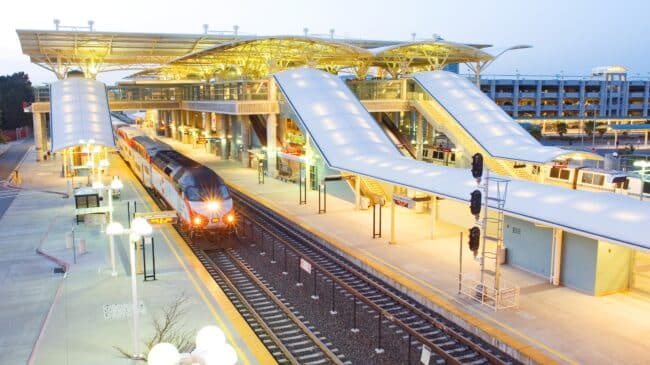Despite a steep drop in ridership, BART (Bay Area Rapid Transit) continues to spend millions of dollars planning and advocating for a second transbay tunnel. While this idea might have made sense when it was proposed in 2016, developments since have crushed the case for a new transit crossing.
Last year, BART, working with the agency that operates Capitol Corridor service between San Jose and Sacramento, launched a program called Link21 to advance the second tunnel and other unspecified projects to improve passenger rail service in a 21-county Northern California “megaregion.” While expanding the potential service area to such far-flung places as Placerville and Salinas might be effective marketing, it is hard to imagine residents of those communities making much use of a rail tunnel between San Francisco and Oakland.
The Link21 website uses outdated population projections to exaggerate the transit needs of this megalopolis. Link21 claims the region will expand from 12.2 million people in 2015 to 16 million people in 2050, but the latest California Department of Finance projections indicate the region is only expected to reach 14.9 million people by 2050. It is worth noting those state projections were released prior to the COVID-19 pandemic population decline in the 21 counties of 50,000 people between July 2020 and July 2021. Given recent birth, death, and migration patterns it is plausible the region’s population could stagnate below 13 million in the decades ahead.
And going forward, fewer Bay Area residents will be jamming into transbay BART trains at rush hour compared to when the existing tunnel operated near capacity several years ago. As shown in a recent fiscal outlook presentation to the BART board, average weekday ridership peaked at just under 440,000 in the 2016 fiscal year. Ridership declined gradually until the onset of the pandemic when it then cratered to below 100,000 riders before beginning a gradual recovery.
By last October, BART had reached 28% of pre-pandemic ridership, a proportion below almost every other major subway and commuter rail system in the United States including those in New York City, Chicago, Philadelphia, Washington, D.C., and Atlanta. This is likely less an indictment of BART than the reality that more of the Bay Area’s tech-heavy workforce can work from home permanently.
BART does not expect anything near a full recovery of its ridership anytime soon. By 2032, even assuming successful completion of the extension to San Jose and Santa Clara, BART ridership is projected to reach only 70% of pre-pandemic projections. And few passengers boarding at new BART stations in the South Bay would use a tunnel between Oakland and San Francisco because they could simply take Caltrain to reach downtown San Francisco.
BART management is so concerned about the loss of passenger revenue that it is considering a new sales tax measure for the 2024 ballot to cover operating deficits once federal stimulus support runs out. But if BART is so worried about decreased ridership, why continue work on a second tunnel that would most likely add unused capacity?
Especially considering the enormous cost of the proposed new tunnel. Link21 estimates the entire project, including the tunnel, new stations, and connecting tracks, would cost $29 billion. Previous major transportation infrastructure projects, such as the California high-speed rail system approved by voters in 2008 and the Bay Bridge replacement, suggest that initial cost estimates are likely far below the final cost of completion.
Currently, Link21 spends funds from Measure RR (2016) bonds, Regional Measure 3 toll revenues, and the state on researching and advocating for the tunnel. The total cost of Link21 is estimated to be $1 billion, none of which is slated for actual construction. Rather than promote and plan an unneeded project, BART and partner agencies should use these funds to improve existing transit service.
A version of this column first appeared in The Mercury News.

